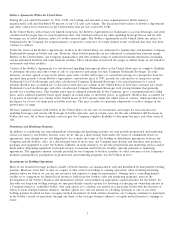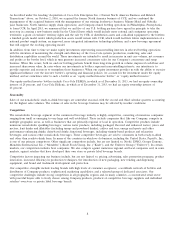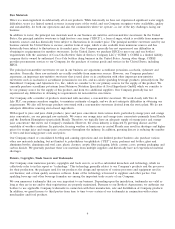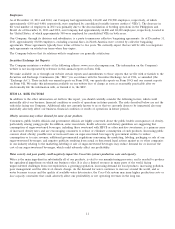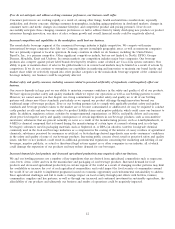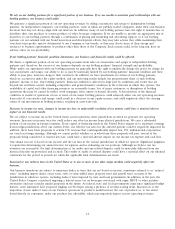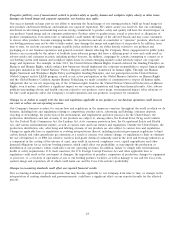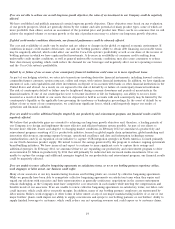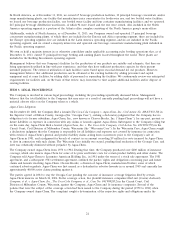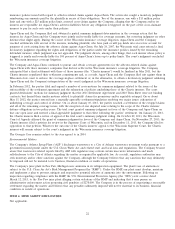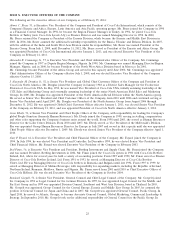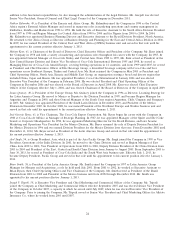Coca Cola 2013 Annual Report Download - page 18
Download and view the complete annual report
Please find page 18 of the 2013 Coca Cola annual report below. You can navigate through the pages in the report by either clicking on the pages listed below, or by using the keyword search tool below to find specific information within the annual report.Significant additional labeling or warning requirements or limitations on the availability of our products may inhibit sales of affected
products.
Various jurisdictions may seek to adopt significant additional product labeling or warning requirements or limitations on the
availability of our products relating to the content or perceived adverse health consequences of certain of our products. For
example, New York City attempted in 2012 to limit the size of cups used to serve our products in foodservice establishments to
a maximum of 16 ounces. (Litigation regarding this limit is currently on appeal.) If these types of requirements become
applicable to one or more of our major products under current or future environmental or health laws or regulations, they may
inhibit sales of such products. Under one such law in California, known as Proposition 65, if the state has determined that a
substance causes cancer or harms human reproduction, a warning must appear on any product sold in the state containing that
substance. The state maintains lists of these substances and periodically adds other substances to these lists. Proposition 65
exposes all food and beverage producers to the possibility of having to provide warnings on their products in California because
it does not provide for any generally applicable quantitative threshold below which the presence of a listed substance is exempt
from the warning requirement. Consequently, the detection of even a trace amount of a listed substance can subject an affected
product to the requirement of a warning label. However, Proposition 65 does not require a warning if the manufacturer of a
product can demonstrate that the use of the product in question exposes consumers to a daily quantity of a listed substance that is
below a ‘‘safe harbor’’ threshold that may be established, is naturally occurring, is the result of necessary cooking or is subject to
another applicable exception. One or more substances that are currently on the Proposition 65 lists, or that may be added to the
lists in the future, can be detected in Company products at low levels that are safe. With respect to substances that have not yet
been listed under Proposition 65, the Company takes the position that listing is not scientifically justified. With respect to
substances that are already listed, the Company takes the position that the presence of each such substance in Company products
is subject to an applicable exemption from the warning requirement. The State of California and other parties, however, have in
the past taken and may in the future take a contrary position. If we were required to add Proposition 65 warnings on the labels of
one or more of our beverage products produced for sale in California, the resulting consumer reaction to the warnings and
possible adverse publicity could negatively affect our sales both in California and in other markets.
If we are unable to protect our information systems against service interruption, misappropriation of data or breaches of security, our
operations could be disrupted and our reputation may be damaged.
We rely on networks and information systems and other technology (‘‘information systems’’), including the Internet and third-party
hosted services, to support a variety of business processes and activities, including procurement and supply chain, manufacturing,
distribution, invoicing and collection of payments. We use information systems to process financial information and results of
operations for internal reporting purposes and to comply with regulatory financial reporting, legal and tax requirements. In
addition, we depend on information systems for digital marketing activities and electronic communications among our locations
around the world and between Company personnel and our bottlers and other customers, suppliers and consumers. Because
information systems are critical to many of the Company’s operating activities, our business may be impacted by system
shutdowns, service disruptions or security breaches. These incidents may be caused by failures during routine operations such as
system upgrades or user errors, as well as network or hardware failures, malicious or disruptive software, computer hackers, rogue
employees or contractors, cyber-attacks by criminal groups or activist organizations, geopolitical events, natural disasters, failures
or impairments of telecommunications networks, or other catastrophic events. In addition, such incidents could result in
unauthorized disclosure of material confidential information. If our information systems suffer severe damage, disruption or
shutdown and our business continuity plans do not effectively resolve the issues in a timely manner, we could experience delays in
reporting our financial results and we may lose revenue and profits as a result of our inability to timely manufacture, distribute,
invoice and collect payments for concentrate or finished products. Misuse, leakage or falsification of information could result in a
violation of data privacy laws and regulations, damage the reputation and credibility of the Company and have a negative impact
on net operating revenues. In addition, we may suffer financial and reputational damage because of lost or misappropriated
confidential information belonging to us, our current or former employees or to our bottling partners, other customers, suppliers
or consumers, and may become subject to legal action and increased regulatory oversight. The Company could also be required to
spend significant financial and other resources to remedy the damage caused by a security breach or to repair or replace networks
and information systems.
Like most major corporations, the Company’s information systems are a target of attacks. Although the incidents that we have
experienced to date have not had a material effect on our business, financial condition or results of operations, there can be no
assurance that such incidents will not have a material adverse effect on us in the future. In order to address risks to our
information systems, we continue to make investments in personnel, technologies, cyber-insurance and training of Company
personnel. The Company maintains an information risk management program which is supervised by information technology
management and reviewed by a cross-functional committee. As part of this program, reports which include analysis of emerging
risks as well as the Company’s plans and strategies to address them are regularly prepared and presented to senior management.
16



